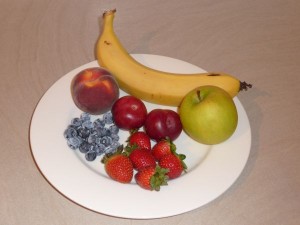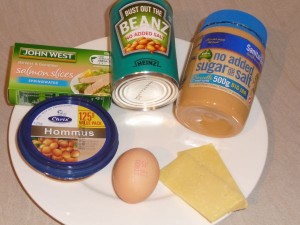One form of bread and cereal – bread, bread rolls, pita bread, tortillas, rice, pasta, crackers that don’t have heaps of salt, sushi
+
Some dairy or soy alternative – cheese and yoghurt are the common options. There are all sorts of cheese – cottage cheese, cheese sticks, chunks of cheddar. Yoghurt can be purchased in big containers and then portioned out to suit your child in smaller lunch tubs.
+
Fruit – seasonal fruit tastes the best. Put fruit that easily gets squished into little containers to protect it. Common fruit options include apples, bananas, grapes but depending on your child it could be strawberries, kiwifruit, stone fruit in summer, blueberries, pears, oranges and mandarins in winter.
+
Protein – you may be limited with options if the school is nut free. Options include: leftover roast meat, chicken, ham, tuna or salmon, hard boiled egg, baked beans, hommous, peanut butter (if allowed at school), cheese, cottage cheese
+
One vegetable for munch and crunch time – carrot sticks, celery sticks, cucumber sticks, sliced capsicum, cherry tomatoes, lettuce or baby spinach leaves (its amazing how many kids will eat these), sliced radish
Healthy school lunch boxes vary depending on the child. Some children like variety and the lunch box has to be swapped around every few days. Other children will happily eat the same types of lunches week in, week out.
It is perfectly ok to send the same lunch every day if it is healthy (eg cheese sandwich, apple, carrot sticks).
The benefits of sending a healthy lunch box can be obvious – good concentration in class, plenty of energy and then the less obvious benefits such as teeth without fillings, kids that aren’t struggling with body weight issues.
The obvious problem is getting kids to eat the healthy foods! Persevere, persevere, persevere – and if you still have troubles go and talk to an Accredited Practising Dietitian.
If you purchase fruit and vegetables in season you will only pay $2-4 per kg, if possible buy small pieces of fruit to reduce wastage. For a giggle look at the cost per kg (not cost per 100g) of other common processed kid snacks. Some of them are around $23/kg!
You will have other wise tips for fellow parents, feel free to post them on the blog. Wishing you and your children a happy and stress free year at school. Cathie Lowe






